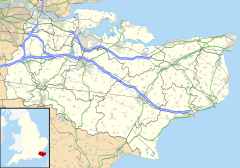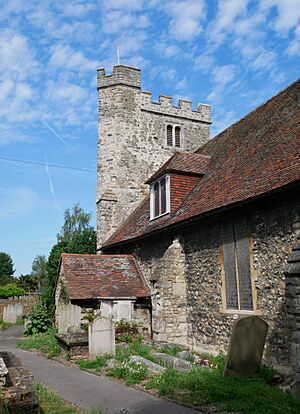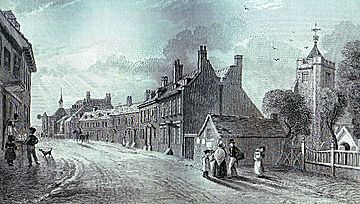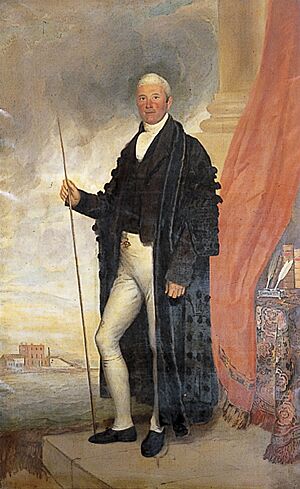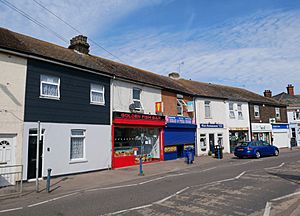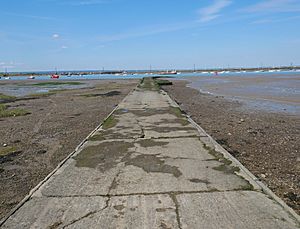Queenborough facts for kids
Quick facts for kids Queenborough |
|
|---|---|
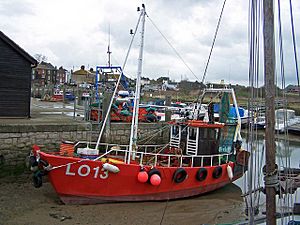 The Creek |
|
| Population | 3,407 (2011 Census) |
| OS grid reference | TQ908724 |
| District | |
| Shire county | |
| Region | |
| Country | England |
| Sovereign state | United Kingdom |
| Post town | QUEENBOROUGH |
| Postcode district | ME11 |
| Dialling code | 01795 |
| Police | Kent |
| Fire | Kent |
| Ambulance | South East Coast |
| EU Parliament | South East England |
| UK Parliament |
|
Queenborough is a town located on the Isle of Sheppey in Kent, South East England. It's part of the Swale area.
This town is about 2 miles (3.2 km) south of Sheerness. It grew into an important port. Queenborough is located near the Thames Estuary, where the River Medway meets the Swale. It's also part of the Sittingbourne and Sheppey area for Parliament.
Queenborough Harbour offers places for boats to dock between the Thames and Medway rivers. Boats can land here at any time, no matter the tide. There are also places to build and fix boats in the marina. It's said that Admiral Lord Nelson learned many of his sailing skills in these waters. He also supposedly shared a house near the small harbour with Lady Hamilton.
Today, Queenborough still shows signs of its history as a seafaring town from the 1700s. Many of its older buildings from that time are still standing. The church is the only building left from the medieval period. The town first had two members of parliament in 1572.
Contents
Queenborough's Rich History
Early Beginnings: Saxon Times
Long ago, in Saxon times, the place where Queenborough now stands was called Cyningburh. This name meant "king's borough" or "king's fortified town."
Medieval and Tudor Eras
A strong fort was built here to protect ships sailing along the Swale. This fort was called Sheppey Castle or Queenborough Castle. King Edward III ordered it to be built between 1361 and 1377. This was during the Hundred Years' War with France. The new castle was built on the site of an older, smaller one.
The castle had a very unusual design. It was round and perfectly symmetrical. Historians described it as a great example of round and strong castle building. They also thought its design might have been made to defend against and use gunpowder artillery. Queenborough was the only truly round castle built in England. It became important again in the 1500s. It might have even influenced the design of nearby Deal Castle and Walmer Castle.
In those days, north Kent had many open waters and marshes. The safest way for ships to reach the open sea was through the Thames into the Yantlet Creek. Then they would go into the Swale from the Medway estuary. From there, they would sail around the Isle of Sheppey into the Wantsum Channel, past the Isle of Thanet to Sandwich. Only then would they reach the open English Channel. This made Queenborough an easy-to-defend town for the wool trade.
King Edward III renamed the town after his Queen, Philippa of Hainault. He gave it the rights of a free borough, which meant it could govern itself. It had a mayor and two bailiffs. He gave Queenborough a special charter in 1366. Two years later, he made it a royal borough.
During this time, Queenborough was very important for exporting wool. Wool was a big source of money for the king. In 1368, the Wool Staple (a place where wool was officially traded) moved from Canterbury to Queenborough. This made Queenborough and Sandwich the two main wool trading centers in Kent.
Archaeologists from the Channel 4 TV show Time Team dug up the castle in 2005.
The town first had two members of parliament in 1572. One of its early MPs was the explorer Sir Humphrey Gilbert in 1580. In 1579, Matthias Falconer from Brabant started England's first copperas factory in Queenborough.
The 1600s: Challenges and Changes
King Charles I officially made the town a "mayor, jurats, bailiffs and burgesses of Queenborough." At this time, most people worked in the local oyster fishing industry. However, the fort, which had protected the Swale and Medway rivers for 300 years, never actually saw any battles.
After the Civil War, Parliamentarians took control of the fort in 1650. They decided it was not useful and could not be fixed. So, it was torn down during the time when England had no king.
Soon after the fort was demolished, in 1667, the Dutch attacked. They captured the new Sheerness fort, which was still being built. They also invaded Queenborough. The Dutch stayed for only a few days. They caused a lot of panic but could not keep up their attack. They left after capturing the ship Royal Charles and burning many other ships in the Thames and Medway.
After this attack, people paid more attention to improving the naval defenses of the Medway. This helped the economy of Queenborough and Sheppey. About 300 years later, in 1967, Queenborough became a twin town with Brielle in the Netherlands.
Work began to fix up the parish church in 1690.
The 1700s: Growth and Decline
The church repairs continued until 1730. Many new houses were built in the growing town during the 1700s. Queenborough did well because of the good trade during this time. Queenborough Guildhall was finished in 1793.
However, Queenborough started to lose its importance. The Yantlet creek and Wantsum channel became filled with mud, making them harder to navigate. Also, new, better ways to sail through the Thames estuary to London were found. The writer Daniel Defoe called Queenborough "a miserable and dirty fishing town." He said the main businesses were "alehouse keepers and oyster catchers."
The Royal Navy started to use the River Medway less. Other dockyards became more important, and ships grew too big for the Medway. So, prison hulks (old ships used as prisons) often replaced the navy ships. These prison ships would sometimes leave dead prisoners on a salt marsh at the mouth of the Swale. This place became known as Dead Man's Island and can still be found on maps today. New forts and harbors built at Sheerness also took over Queenborough's role. Sheerness was better located at the mouth of the Medway.
From the 1800s to Today
Records from 1815 to 1820 show that the Queenborough town council had money problems. They owed about £14,500, which they could not pay back. It seems that the mayor and other officials had not been honest with the public money. This caused big financial problems for the fishers and oyster catchers. They protested against unfair charges on their trade.
Conditions became so bad that by the mid-1800s, the council was bankrupt. A key person in these problems was Thomas Young Greet, who was often the mayor and treasurer. He and his friends used their positions to take money from the fisheries. Parliament had to step in. Through an Act of Parliament, much of the town's business was given to trustees. They helped the economy by selling land, property, and the old oyster fishery. The oyster trade had been hurt by smuggling and bribery. Because of this, the town lost its right to have Members of Parliament in the Reform Act of 1832.
Queenborough's economy got a big boost when a branch railway line was built from Sittingbourne. This railway, part of the London, Chatham & Dover Railway, worked with a mail and passenger boat service to Vlissingen in the Netherlands. A bridge was built over the Swale when the railway was constructed in 1860.
The town started to recover from its tough times in the 1850s. New industries came to Queenborough, including a glass factory and a company that cleaned coal. Many other small businesses also started, like potteries, the Sheppy Fertilizer company (using an old spelling of Sheppey), and a glue factory. The Portland cement factory opened in 1890. Today, there is still a lot of trade in timber.
A new town charter in 1885 gave some new energy to the struggling town council. But it wasn't until 1937 that the Charity Commissioners could finally appoint a proper town council. However, the town and its fisheries never fully recovered. Today, the Swale Borough Council acts as the trustees. This council took over the old town council in the local government reorganization of 1974. Queenborough now has its own town council, which includes a mayor.
Modern sea wall defenses have changed the look of the beaches. But they were needed to protect the town. There is a large yachting harbor now. The pirate radio ship Radio Caroline even anchored there for a while in 2003–04. Today, tourism is a big part of the island's economy. Queenborough benefits from local investments in this area.
People and Population (Demography)
| Queenborough | Borough of Swale | England | |
|---|---|---|---|
| Total population | 3,471 | 122,801 | 49,138,831 |
| Foreign born | 2.8% | 3.6% | 9.2% |
| White | 99% | 98% | 91% |
| Asian | 0.4% | 0.7% | 4.6% |
| Black | 0.3% | 0.3% | 2.3% |
| Christian | 78% | 76% | 72% |
| Muslim | 0.1% | 0.4% | 3.1% |
| No religion | 15% | 15% | 15% |
| Over 65 years old | 13% | 16% | 16% |
| Bachelor's degree or higher | 7% | 12% | 20% |
In the 2001 UK census, the area of Queenborough had 3,471 people living there.
For every 100 females, there were 94.5 males. The ages of people were:
- 7% were 0–4 years old.
- 18% were 5–15 years old.
- 10% were 16–24 years old.
- 28% were 25–44 years old.
- 23% were 45–64 years old.
- 13% were 65 years old and over.
The ethnicity of people in the Queenborough and Halfway voting area was mostly white (98.6%). Other groups included mixed race (0.7%), black (0.3%), non-Chinese Asian (0.2%), and Chinese or other (0.3%).
Most residents (97.2%) were born in the United Kingdom. Smaller numbers were born in the Republic of Ireland (0.6%), Germany (0.4%), and other countries.
Regarding religion, 77.6% were Christian. A small number were Muslim (0.1%) or Jewish (0.1%). About 14.7% said they had no religion.
About 7% of Queenborough and Halfway residents aged 16–74 had a bachelor's degree or higher. This is lower than the national average of 20%.
Queenborough's Economy
New businesses in Queenborough include a modern pharmaceutical factory and laboratories. There is also a steel rolling mill. However, the steel mill has faced challenges due to rules on American steel trade.
In the 2001 UK census, here's how people aged 16–74 in Queenborough and nearby villages worked:
- 42.0% had full-time jobs.
- 12.7% had part-time jobs.
- 7.1% were self-employed.
- 3.4% were unemployed.
- 1.5% were students with jobs.
- 3.0% were students without jobs.
- 14.6% were retired.
- 8.0% were looking after their home or family.
- 5.3% were permanently sick or disabled.
- 2.4% were not working for other reasons.
The unemployment rate of 3.40% was very close to the national rate of 3.35%.
The main industries where residents worked were:
- 24% in manufacturing.
- 16% in retail (shops).
- 9% in construction.
- 9% in real estate.
- 10% in transport & communications.
- 7% in health & social work.
- 7% in public administration (government jobs).
- 5% in education.
- 4% in hotels & restaurants.
- 2% in finance.
- 1% in agriculture.
- 3% in other community, social, or personal services.
Compared to the rest of the country, Queenborough had more workers in manufacturing, construction, public administration, and transport & communications. It had fewer workers in agriculture, health & social work, education, finance, and real estate.
Local Media
Local news and TV shows for Queenborough come from BBC South East and ITV Meridian. TV signals are received from the Bluebell Hill TV transmitter.
The town is served by county-wide radio stations like BBC Radio Kent, Heart South, and Gold Radio. There are also local community radio stations: BRFM 95.6 FM and Sheppey FM 92.2.
The Sheerness Times Guardian is the local weekly newspaper.
Getting Around: Transport Links
Rail Travel
Trains run through Queenborough railway station on the Sheerness line. This line connects Sittingbourne (where you can link to the wider rail network) with Sheerness-on-Sea.
Sailing and Boats
Queenborough's harbor and creek on the Isle of Sheppey have places for many different kinds of boats to dock. There is a landing area at Crundells Wharf that can be used by boat owners and visiting sailors. You can land here at any tide.
See also
 In Spanish: Queenborough para niños
In Spanish: Queenborough para niños


